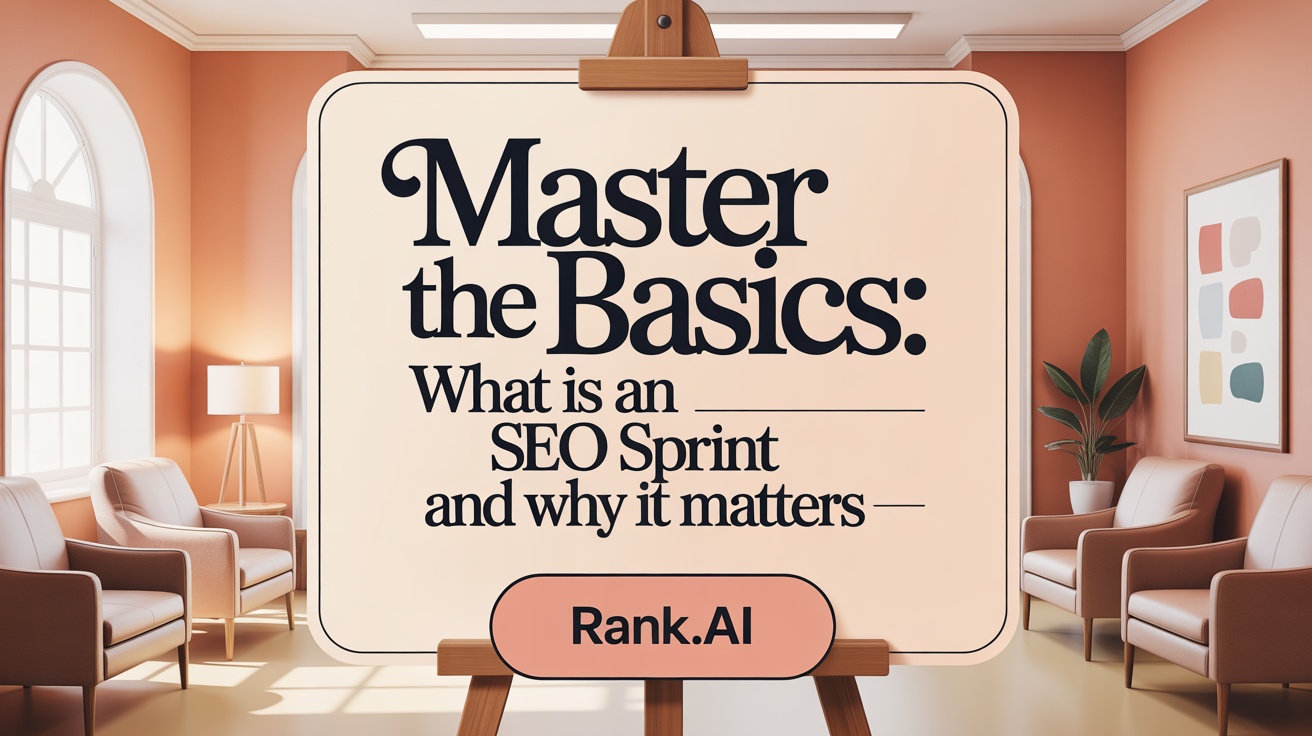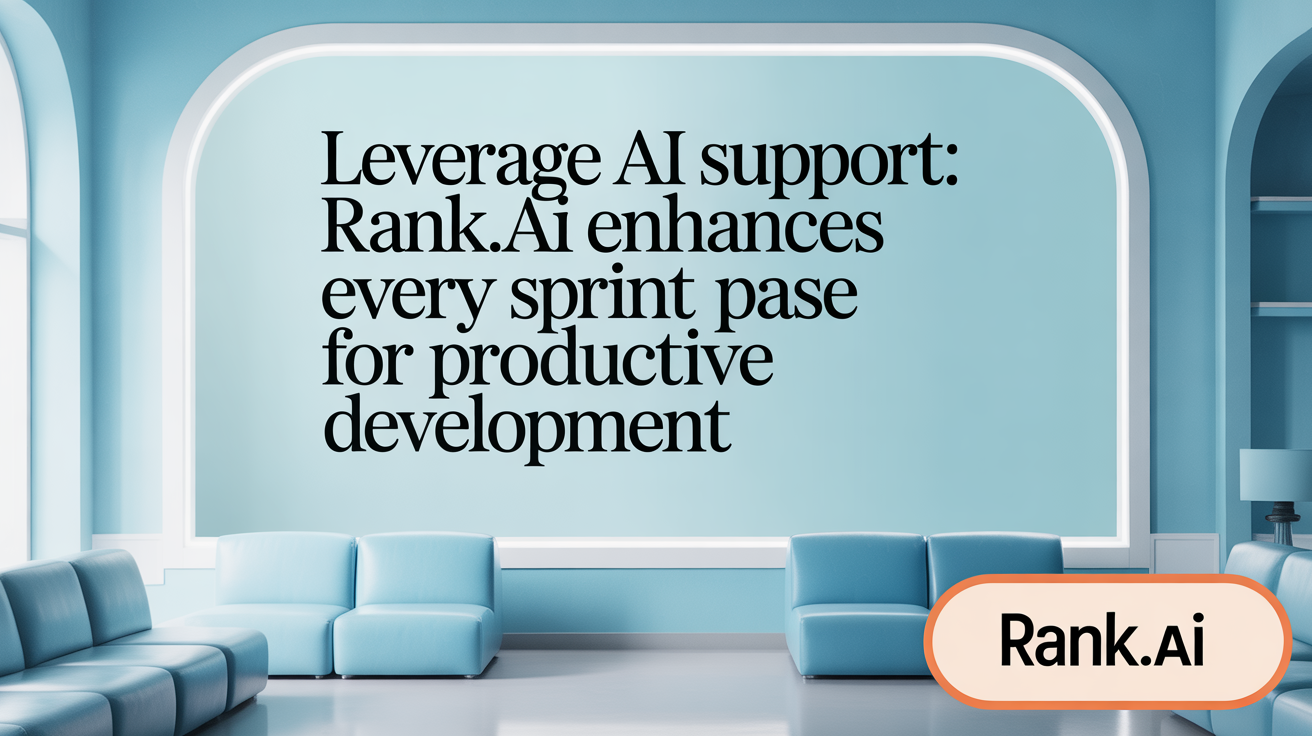Understanding the Power and Precision of SEO Sprints
In the fast-paced digital marketing landscape, SEO sprints offer companies a rapid, focused approach to improve search engine visibility and performance. Leveraging innovative tools like Rank.ai, these sprints maximize efficiency through AI-driven insights and automation, enabling businesses to achieve measurable SEO gains within a condensed timeframe. This article unpacks the core principles, methodologies, and benefits of SEO sprints enhanced by Rank.ai, revealing how strategic agility and cutting-edge technology converge to accelerate organic growth.
Defining an SEO Sprint: Focused, Time-Bound SEO Initiatives

What is an SEO sprint?
An SEO sprint is a concentrated, short-term effort designed to rapidly improve a website's search engine performance. Lasting typically 3 to 4 months, it aims to address specific challenges or test the impact of SEO strategies quickly.
The process is structured into six distinct phases: goal setting, data gathering and analysis, strategy planning, execution, measurement, and scaling or continuation. This clear framework helps teams stay focused and make data-driven decisions.
The core idea revolves around rapid, iterative improvements. This includes fixing technical issues like slow load times and broken links, optimizing on-page content such as titles and meta descriptions, building backlinks, and adjusting on-site structures.
SEO sprints emphasize quick wins—achieving tangible results such as higher rankings or increased traffic within a short window. They serve as cost-effective strategies, ideal for startups needing fast results or larger enterprises testing new SEO approaches.
Overall, the goal of an SEO sprint is to produce measurable outcomes in a condensed time frame. This approach allows brands to identify profitable opportunities, resolve urgent problems, and lay a foundation for long-term success—all while maintaining flexibility and speed.
The Structure and Methodology Behind an SEO Sprint

What is the typical structure and methodology of an SEO sprint?
An SEO sprint follows a structured and focused approach, typically divided into several distinct phases designed to produce rapid improvements in search engine rankings. These phases ensure that actions are targeted, measurable, and efficient, capitalizing on Google's quick indexing when possible.
The process generally includes planning, execution, and review cycles, with each stage building on the insights of the previous one. It often begins with a thorough website audit using diagnostic tools such as Ahrefs, Sitebulb, or proprietary apps like Fizz+Ginger, to uncover technical issues, content gaps, and ranking opportunities.
Once issues and priorities are identified, clear goals are set based on data analysis, focusing on high-impact tasks like fixing broken links, optimizing on-page elements, improving site speed, or enhancing content relevance.
During the execution phase, teams work on targeted tasks—ranging from technical fixes to content updates—while documenting every change for proof of work. Prioritization is based on potential impact, aiming to deliver visible results within a short timeframe, usually between 1 to 3 months.
Regular check-ins and monitoring ensure adjustments are made if strategies are not delivering expected results. After implementation, the review phase involves measuring outcomes against KPIs such as traffic growth, keyword rankings, and conversions.
Results are analyzed to determine success and inform subsequent cycles. This iterative approach allows for continuous improvement, making SEO sprints highly effective for quick wins or tackling urgent issues.
Six phases of SEO sprint process
| Phase | Description | Typical Duration | Main Activities |
|---|---|---|---|
| 1. Define Goals | Set clear, measurable objectives based on business needs and current performance | 1 week | Goal setting, benchmarking, KPI selection |
| 2. Data Gathering | Collect comprehensive data to identify issues and opportunities | 1-2 weeks | Website audits, keyword research, competitor analysis |
| 3. Strategy Planning | Develop a targeted action plan aligned with goals | 1 week | Task prioritization, resource allocation |
| 4. Implementation & Execution | Carry out prioritized tasks | 2-4 weeks | Technical fixes, content updates, link building |
| 5. Measurement | Analyze results to gauge impact | 1 week | Monitoring KPIs, logging changes |
| 6. Iteration or Scaling | Refine strategies or expand successful tactics | 1-2 weeks | Adjustments, planning for subsequent sprints |
Planning, execution, and review cycles
The lifecycle of an SEO sprint emphasizes a cycle of planning, action, and review. Planning involves setting realistic objectives rooted in data analysis. Execution focuses on implementing high-impact tasks efficiently within a set timeframe.
The review cycle benchmarks success, using KPIs such as rankings, traffic, and conversions. Based on insights gained, teams may repeat the cycle or scale up efforts on proven strategies.
Prioritization and documentation of tasks
Prioritization is crucial; tasks are ranked by potential impact and ease of implementation, often guided by diagnostic reports. Documentation, including before-and-after screenshots and detailed notes, ensures transparency and provides proof of work.
This methodical approach enables teams to deliver noticeable results quickly, adapt dynamically, and sustainably improve SEO performance through structured, short-term projects.
Key Activities and Strategies Within an SEO Sprint
 An SEO sprint is a concentrated effort designed to quickly boost a website’s visibility in search engine results. This approach involves a series of tactical activities carried out within a strict timeframe, generally up to eight weeks. The goal is to implement high-impact changes that can produce measurable improvements rapidly.
An SEO sprint is a concentrated effort designed to quickly boost a website’s visibility in search engine results. This approach involves a series of tactical activities carried out within a strict timeframe, generally up to eight weeks. The goal is to implement high-impact changes that can produce measurable improvements rapidly.
One of the first steps in an SEO sprint is comprehensive keyword research. This helps identify high-priority opportunities, such as keywords that are close to ranking on the first page or high-opportunity terms with significant search volume. Analyzing search intent and competition levels allows teams to focus their efforts on the most promising keywords.
On-page SEO and technical fixes form the backbone of the Sprint activities. This includes optimizing title tags, meta descriptions, and headers to align with targeted keywords. Technical issues—such as slow page speeds, broken links, missing alt tags, or crawl errors—are prioritized and resolved using diagnostic tools like Ahrefs, Screaming Frog, or HubSpot integrations. Ensuring the website is secure with HTTPS, has a proper sitemap, and is easily navigable enhances crawlability and user experience.
Content optimization and link-building efforts also play vital roles in an SEO sprint. This could involve updating existing content to better target keywords, creating new high-value content, or deploying internal linking strategies to distribute link equity effectively. Outreach campaigns for backlinks are often executed during this period, aiming to acquire authoritative links that boost rankings.
Regular monitoring and adjustments are essential to the success of an SEO sprint. Throughout the process, performance metrics such as organic traffic, keyword rankings, click-through rates, and site speed are tracked using tools like Google Analytics and Search Console. This data guides ongoing refinements, ensuring that changes made during the sprint lead to concrete results.
Overall, an SEO sprint is a disciplined, focused effort that combines strategic planning with tactical execution. By aligning activities like keyword research, technical improvements, content updates, and link-building under a short-term, goal-oriented framework, businesses can achieve rapid increases in search visibility and organic traffic.
More info: Search queries like 'Key SEO sprint activities and best practices' can provide further guidance on optimizing short-term SEO campaigns for maximum impact.
Introducing Rank.ai: Revolutionizing SEO Sprints with AI

Overview of Rank.ai and its AI-driven capabilities
Rank.ai is an innovative platform designed to elevate the effectiveness of SEO strategies through advanced artificial intelligence. It offers tools that automate and optimize key SEO tasks, including keyword research, content analysis, backlink monitoring, and performance tracking. By harnessing AI, Rank.ai provides rapid insights into search engine ranking factors and user behavior, enabling marketers to make data-driven decisions faster than traditional methods.
The platform's AI-driven capabilities allow for continuous monitoring of search engine algorithm changes, tracking brand visibility across various search engines and AI-powered answer engines like ChatGPT and Perplexity. This comprehensive approach helps ensure that businesses maintain a strong presence in both traditional and emerging search environments.
Integration with search engine ranking signals
Rank.ai deeply integrates with search engine ranking signals, analyzing how modifications to a website influence its position in SERPs. It maps out ranking factors such as on-page content quality, backlinks, and website structure, aligning them with real-time search performance metrics. This integration supports rapid, iterative SEO adjustments, enabling teams to respond swiftly as search algorithms evolve.
The platform also offers insights into emerging AI-driven search behaviors, allowing brands to adapt their content and SEO tactics to stay ahead in an increasingly AI-centric search landscape.
Support for SEO sprint phases through automation and insights
During an SEO sprint, efficiency and speed are essential. Rank.ai supports every phase—from goal setting and data gathering to strategy and execution—with automation tools that save hours of manual work.
In the initial phases, it automates keyword clustering, competitor analysis, and technical site auditing, providing a clear picture of current performance. For strategy development, Rank.ai offers predictive insights on high-impact keywords and content gaps.
Throughout the implementation phase, the platform automates on-page optimizations, backlink outreach tracking, and content updates, ensuring that tasks are executed systematically and on time. Post-implementation, Rank.ai continuously measures results, providing dashboards that highlight improvements in rankings, visibility, and traffic. Its iterative features recommend next steps based on real-time data, making it an indispensable tool in fast-paced SEO sprints.
By integrating AI-powered automation and analytics, Rank.ai empowers marketers to conduct highly focused, data-driven SEO sprints that deliver measurable results in a fraction of the time needed for traditional SEO approaches.
How Rank.ai Supports Each Phase of an SEO Sprint

Data gathering and keyword research
Rank.ai offers AI-driven tools that simplify the process of collecting and analyzing search data. It helps identify high-potential keywords by clustering search terms based on user intent and competitive difficulty. This allows teams to focus on low-competition, high-opportunity keywords that are close to ranking on the first page. The platform provides insights into search trends, volume, and relevance, streamlining initial data collection.
Content structuring and technical SEO optimization
During the content planning stage, Rank.ai aids in structuring articles and web pages to align with best SEO practices. It suggests optimized meta descriptions, headings, and schema markup, enhancing the page’s indexability. The platform also offers recommendations for technical fixes such as speed enhancements, URL structure improvements, and internal linking, ensuring the website is well-optimized for search engines.
Performance measurement and iteration
Rank.ai continuously monitors the performance of implemented strategies by tracking key metrics like keyword rankings, organic traffic, and conversion rates. It visualizes data through dashboards and provides actionable insights for refining tactics. Whether to scale the current effort or pivot to new strategies, the platform facilitates quick adjustments based on real-time results, supporting an iterative approach to SEO sprints.
More about how Rank.ai supports various phases of an SEO sprint
Using Rank.ai throughout the SEO sprint lifecycle enables teams to execute focused, data-driven initiatives efficiently. It reduces manual effort in data analysis, accelerates content production, and offers precise technical guidance. This allows businesses to achieve rapid improvements in rankings, visibility, and traffic, maximizing the impact of each sprint.
Step-by-Step Planning and Implementation of an SEO Sprint with Rank.ai
Embarking on an SEO sprint involves a structured yet flexible approach to rapidly boost your website’s search performance. The process begins with clear goal setting, where you define specific, measurable objectives—whether improving rankings for target keywords, increasing organic traffic, or fixing technical issues.
The first step is conducting a comprehensive audit using diagnostic tools such as Rank.ai, Ahrefs, or SEMrush. These tools help identify critical issues like slow page load speeds, broken links, missing alt tags, or thin content. By understanding your website’s current SEO health, you can craft a focused strategy tailored to your most pressing needs.
Once the audit is complete, prioritize your tasks based on data insights. Analyze keyword difficulty, search volume, and user intent to determine which issues will deliver the highest impact. Develop a roadmap that organizes tasks according to stages of the buyer’s journey—top of funnel (ToFu), middle (MoFu), and bottom (BoFu)—to ensure all aspects of the user experience and conversion funnel are optimized.
Execution is swift and precise. Perform technical fixes such as updating meta descriptions, optimizing images for faster load times, fixing errors like 404s or redirects, and improving internal linking structures. Leverage AI-assisted content creation tools like Penfriend.ai to generate engaging, SEO-optimized content efficiently. Remember, all content should be human-edited to maintain clarity, relevance, and brand voice.
Throughout the sprint, document progress with before-and-after reports, screenshots, and annotations. This not only tracks your improvements but also provides proof of impact for stakeholders.
Finally, measure your results using Google Analytics, Search Console, and Rank.ai’s monitoring features to evaluate changes in rankings, traffic, and engagement. Use this data to refine your strategy, iterating through subsequent sprints to further enhance your SEO performance.
By following these steps—goal setting, auditing, prioritizing, executing, documenting, and measuring—you can harness the full potential of Rank.ai and associated tools to achieve rapid, measurable SEO success in a focused timeframe.
Best Practices for Managing SEO Sprints Using Rank.ai
What are the best practices for managing and optimizing SEO sprints with Rank.ai tools?
Managing an SEO sprint effectively with Rank.ai involves a strategic approach centered on clear goal setting, diligent data analysis, and continual iteration. First, establish specific, measurable objectives that are directly aligned with your overall business goals. For example, targeting keywords in close reach of the first page or aiming to increase organic traffic by a certain percentage.
Next, leverage Rank.ai’s extensive AI-driven features for comprehensive data collection. Conduct thorough keyword research, technical audits, and competitive analysis to identify opportunities and technical issues. Prioritize tasks such as fixing slow-loading pages, optimizing meta tags, and ensuring proper internal linking, all of which are essential for quick wins.
Implementation is the next critical phase. Use Rank.ai's tools to automate content creation, optimize for search intent, and ensure website health is maintained. Focus on creating high-quality content and technical enhancements like schema markup and mobile responsiveness to improve visibility.
Throughout the sprint, maintain consistent monitoring. Use Rank.ai’s analytics dashboards to track keyword rankings, user behavior, and site performance. Regular check-ins allow for data-driven adjustments, whether that means shifting focus to new keywords, refining on-page elements, or addressing emerging technical issues.
Iterative improvements are vital. Each cycle should aim to build on previous wins, gradually improving rankings and engagement metrics. Techniques such as backlink building, internal linking, and content updates should be executed systematically.
Finally, ensure adherence to SEO best practices by continuously improving technical aspects like site speed, security (SSL), and structured data. Regular audits with Rank.ai’s tools facilitate ongoing optimization, helping to sustain and grow results beyond the sprint period.
Benefits and Expected Outcomes of SEO Sprints Enabled by Rank.ai
What are the benefits and expected outcomes of conducting an SEO sprint with Rank.ai tools?
Implementing an SEO sprint with Rank.ai tools provides numerous advantages that help businesses achieve rapid and measurable improvements in their search engine performance. One of the main benefits is the ability to make quick, targeted upgrades to website visibility. By concentrating on high-impact areas—such as fixing technical issues, optimizing on-page elements like titles and meta descriptions, creating strategic content, and building backlinks—sites can see faster improvements compared to traditional, longer-term SEO efforts.
Cost efficiency is another significant advantage. SEO sprints help organizations allocate resources more effectively by focusing on the most impactful tasks within a defined period, often just a few months. This targeted approach reduces unnecessary expenditure and accelerates return on investment.
Moreover, results from SEO sprints are highly measurable. Clear objectives, KPIs, and progress tracking tools ensure that teams can evaluate success accurately and make data-driven decisions. This transparency enhances project management and boosts confidence in the process.
Finally, SEO sprints improve overall site health, making websites more secure, faster, and better structured for both users and search engines. This leads to increased organic traffic and better rankings, all achieved with minimal risk, as the focused nature of sprints minimizes the chance of harming the site.
Using Rank.ai’s comprehensive tools facilitates these quick wins by streamlining diagnostics, automating key tasks, and providing strategic insights—making SEO sprints an efficient and effective method for fast scaling and optimization.
SEO Sprints vs. Traditional SEO: A Comparitive Perspective
How do SEO sprints integrate with an overall SEO strategy and workflow?
SEO sprints serve as targeted, short-term initiatives within a broader SEO strategy. They focus on quickly addressing specific issues or testing new approaches to generate rapid, measurable results. These sprints typically last around 100 days and involve a structured process: defining goals, gathering data, planning strategies, executing fixes or optimizations, and measuring outcomes.
In practice, SEO sprints complement long-term efforts by providing tactical boosts that can impact rankings, traffic, or conversions in a brief period. They are particularly useful for fixing critical technical problems, improving high-priority keywords, or capitalizing on emerging opportunities.
While traditional SEO involves ongoing, broad activities such as continuous content creation, link building, and technical maintenance, sprints are more focused and intense. They allow teams to adapt quickly, incorporate new insights, and respond to algorithm updates or competitive movements.
By integrating SEO sprints into existing workflows, organizations can maintain a balance between steady, long-term growth and rapid tactical wins. This integration helps prioritize resources efficiently and ensures that short-term actions are aligned with overarching business goals, ultimately creating a dynamic, responsive SEO strategy that evolves with the digital landscape.
Technical SEO and Performance Optimization in SEO Sprints
What are the main technical elements to focus on during an SEO sprint?
In an SEO sprint, concentrating on core technical elements ensures rapid and impactful improvements. These include optimizing site speed, ensuring crawlability, and securing the site with SSL protocols.
Site speed is critical because it affects user experience and search rankings. Tools like Google PageSpeed Insights and GTMetrix help diagnose speed issues such as large images, slow server response times, or unnecessary code.
Crawlability refers to how easily search engines can access and index website pages. Proper configuration of robots.txt files, sitemaps, and canonical tags ensures that search engines can efficiently crawl the most important content.
SSL security (HTTPS) is vital for building trust with users and is a ranking factor for Google. Ensuring all pages are secured by SSL certificates protects data and improves SEO credibility.
How are diagnostic tools used for site audits during an SEO sprint?
Diagnostic tools are fundamental for identifying issues that hinder SEO performance. Tools like Ahrefs, Sitebulb, and Google Search Console generate comprehensive site audits.
These audits reveal common issues such as missing or duplicate meta descriptions, broken links, slow-loading pages, and security flaws. For example, Sitebulb offers visual reports on crawl errors and page speed bottlenecks.
By building a task backlog from these insights, teams can prioritize fixes that will deliver the greatest impact within the sprint timeframe. Documenting before-and-after results further helps verify progress.
Why is internal linking and site architecture important?
Optimizing internal linking improves user navigation and distributes page authority throughout the site. A well-structured site with clear hierarchies enhances both user experience and search engine crawling.
During an SEO sprint, mapping the site’s landing pages to sales funnels helps ensure relevant pages are interconnected efficiently. Strategic use of internal links with optimized anchor text can boost rankings for targeted keywords.
Additionally, planning a logical site architecture reduces duplicate content issues and makes it easier to implement schema markup, further supporting SEO efforts.
| Aspect | Focus Area | Benefits | Tools & Techniques |
|---|---|---|---|
| Site Speed | Load time optimization | Better ranking, improved user experience | Google PageSpeed, GTMetrix, image compression tools |
| Crawlability | Robots.txt and sitemap configuration | Easier indexing, faster penetration into search engines | Google Search Console, Sitemap generators |
| Security | SSL certificate implementation | Builds trust, enhances ranking | SSL/TLS setup, HTTPS redirects |
| Site Architecture | Internal linking, page hierarchy | Improves crawl efficiency, keyword rankings | Mapping tools, strategic linking plans |
This targeted approach to technical SEO in an SEO sprint guarantees swift results by fixing fundamental issues that impact visibility and performance, paving the way for better rankings in minimal time.
AI-Powered Content Creation and Optimization with Rank.ai
How does automated content generation using advanced AI models work?
Rank.ai leverages cutting-edge AI models like GPT-4 to automate the creation of high-quality, relevant content. By inputting target keywords and guidelines, users can generate comprehensive articles, blog posts, or product descriptions almost instantly. These AI models analyze vast amounts of data, including SERP signals and top-ranking content, to craft pieces that are both SEO-friendly and engaging.
This process handles large volumes of content requests by clustering keywords based on user intent and producing optimized drafts. AI-driven tools also help in structuring outlines, filling content gaps, and customizing tone and style, vastly speeding up the content creation pipeline.
How do you ensure high-quality, Google policy-compliant content?
Maintaining quality and adherence to Google’s guidelines is vital when using AI for content creation. Rank.ai emphasizes the importance of human oversight in reviewing AI-generated drafts. Content must be relevant, fact-based, and tailored to the target audience.
Google's policies approve AI-produced content as long as it is not manipulative and offers genuine value. Rank.ai incorporates mechanisms for fact-checking, analysis of source citations, and ensuring originality. Continuous optimization based on performance data and user feedback further aligns content with Google's policies.
How can content workflows be accelerated and relevance enhanced?
AI tools like Rank.ai streamline content workflows by automating research, outline generation, and initial drafts. This reduction in manual effort allows teams to focus on refining and customizing content.
Relevance is enhanced through AI algorithms that analyze search intents, competitor content, and trending topics. They also help identify content gaps and new high-opportunity keywords, ensuring that content stays current and targeted.
Additionally, AI supports content optimization tasks such as meta description generation, internal linking, and feature snippet targeting, enabling faster iteration and continuous improvement. Overall, integrating AI accelerates content production timelines while improving relevance and SEO performance.
Monitoring SEO Performance: Metrics and Tools Used in Sprints
How is SEO performance tracked during sprints?
In SEO sprints, monitoring progress is essential to ensure that efforts lead to measurable results. Marketers focus on key metrics such as organic traffic, keyword rankings, and click-through rates (CTR). Organic traffic indicates how many visitors arrive via search engines, providing a clear indicator of visibility improvements.
Keyword rankings reveal the position of targeted search terms on results pages. Rapid shifts in rankings help gauge the effectiveness of optimization strategies. CTR shows the percentage of users clicking on your site link after seeing it in the SERP, reflecting the relevance and appeal of your content.
Which tools are commonly used for tracking?
Tools like Google Analytics and Google Search Console are fundamental for real-time monitoring. Google Analytics tracks user behavior on your site, including traffic volume, session duration, and conversion rates.
Google Search Console provides insights into keyword rankings, indexing status, and search appearance. It helps identify issues affecting visibility and measures click-through performance for specific queries.
How do dashboards enhance progress reporting?
Many SEO teams incorporate real-time dashboards that aggregate data from various sources. These dashboards offer visual representations of traffic trends, keyword movements, and site health metrics.
Progress reports generated from these dashboards facilitate rapid decision-making. They help teams understand what’s working, where to adjust strategies, and how close they are to achieving sprint goals. Regular updates ensure that everyone remains aligned and can respond swiftly to any emerging challenges.
In summary, tracking SEO performance through the use of analytics tools and dashboards enables quick, data-driven adjustments during an SEO sprint, maximizing the chances of rapid success.
Case Study Insights: Real-World Success with SEO Sprints and Rank.ai
How an SEO Sprint Boosted Organic Traffic and Conversions
In a recent case study, a Danish optician chain, Nyt Syn, demonstrated the powerful impact of an SEO sprint. By focusing on their DriveSafe glasses campaign, they achieved remarkable results in a short timeframe. During their initial SEO sprint, organic traffic surged threefold within just a few months. This rapid increase translated into a significant rise in online bookings, with a reported 73% growth in DriveSafe glasses consultations.
This targeted approach allowed the company to swiftly address specific SEO issues and optimize crucial pages, resulting in improved search visibility for high-value keywords. The success underscores how intensive, goal-oriented SEO efforts can quickly turn around underperforming web pages and create substantial business impact.
Using Multiple Data Sources to Guide Targeting
The Nyt Syn team harnessed a variety of data sources to inform their strategies. Google Search Console provided insights into keyword performance and indexing issues, while Google Analytics tracked user behavior and conversion pathways. Customer chat data offered real-time feedback on consumer interests and pain points.
By analyzing this multifaceted data set, they identified low-competition keywords with high commercial intent that could be rapidly ranked. Additionally, insights on user engagement helped tailor content and on-site elements to better meet customer needs, ensuring that their SEO efforts were both strategic and aligned with actual consumer behavior.
Results and Actionable Tips
The outcome was a clear demonstration of SEO sprint effectiveness: quick ranking improvements, increased organic traffic, and higher conversions. Within 17 days, targeted keywords appeared on Google’s first page, reaching the top three positions by day 30.
For businesses looking to replicate this success, several lessons stand out:
- Set precise, measurable goals before starting.
- Use comprehensive data analysis to identify high-impact keywords.
- Focus efforts on optimizing a select set of high-priority pages.
- Regularly measure progress and adjust strategies accordingly.
Leveraging tools like Rank.ai for tracking search visibility across AI search engines further enhances the ability to monitor and refine SEO tactics in real-time.
This case exemplifies what can be achieved with a focused, data-driven SEO sprint. When combined with continuous measurement and agility, such strategies can lead to significant, rapid growth in organic search performance—illustrating the potent mix of planning, execution, and analytics in mastering modern SEO.
Preparing for Future Search Dynamics: AI and SEO Sprints
Impact of emerging AI search engines on SEO
Recent developments in AI-powered search engines, such as ChatGPT, Perplexity, and Google's Gemini, are redefining how users access information. These AI models excel at research, planning, translation, and content generation, shifting the landscape from traditional keyword-based searches to more conversational and inquiry-driven interactions. As AI becomes more sophisticated in distilling large volumes of data into precise answers, traditional SEO strategies must adapt to prioritize high-quality, relevant content that AI can easily process and incorporate.
Importance of maintaining brand visibility in AI models
Brands need to ensure visibility within AI-powered search engines to stay relevant. Given AI's ability to cite and reference sources, companies should work towards making their content indispensable, authoritative, and easily retrievable by these systems. Strategies include building trust signals, ensuring consistency across content, and actively managing AI answer citations. Using AI SEO tools like Rank Prompt can help track how brands appear in AI models, maintaining a steady presence in the evolving landscape.
Adapting sprint strategies for evolving search behaviors
As AI search capabilities grow, shorter, more focused SEO sprints will become even more essential. These concentrated efforts can quickly optimize for emerging trends, identify high-value keywords, and improve site signals that influence AI accuracy. The traditional long-term approach will be supplemented by rapid, iterative sprints aimed at capturing opportunities in AI-driven search responses. Effective sprints now incorporate AI analysis tools and real-time data to adapt swiftly, ensuring brands stay atop these new search paradigms.
In summary, preparing for future search involves understanding the influence of AI engines, actively maintaining brand presence within these systems, and customizing rapid SEO efforts to align with changing user behaviors. Staying agile and data-driven will be vital in harnessing the full potential of AI in SEO strategies.
Harnessing Agile SEO with Rank.ai for Sustained Growth
SEO sprints powered by Rank.ai tools represent a paradigm shift in how businesses approach search engine optimization—merging agility, precision, and AI-driven insights to deliver rapid and measurable SEO improvements. By embracing focused, data-centric sprints that harness cutting-edge technology, companies can effectively address pressing SEO challenges, accelerate content delivery, and enhance site performance with greater confidence and efficiency. As search landscapes evolve with AI-driven engines and complex ranking factors, integrating SEO sprints into a holistic strategy ensures brands remain competitive, visible, and responsive to emerging opportunities. Ultimately, Rank.ai-enabled SEO sprints empower marketers to transform short-term initiatives into long-term success stories.
References
- What is an SEO Sprint? - Percepture
- Get Results Quickly With SEO Sprints | RevenueZen
- 14 best AI SEO tools & how I use them [new data] - HubSpot Blog
- SEO in an AI-powered world: What changed in just a year
- Blitz SEO: The 30-Day Sprint To Rank #1 | by Ilias Ism - Medium
- How we work: SEO sprints - Articulate Marketing
- The Best AI Tools for SEO & How to Use Them - Botpress
- SEO Sprints - Ranking Serve



